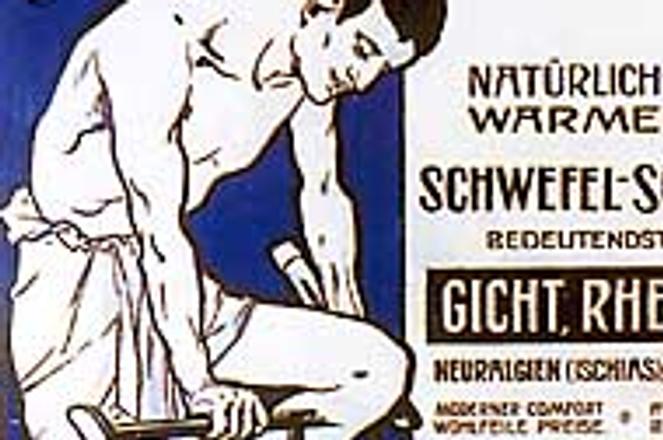EARLY Spa advert on display.photo: Courtesy of Balneological Museum
WHEN Ľudovít Winter, one of the founders of the Piešťany spa, was looking for a trademark for his company, he wanted a symbol of recovery. A young man from the local printing house designed for him a figure of a man breaking a crutch. This was the perfect image, and later became the coat of arms for the city.
The history of the Winter family is closely tied to the city of Piešťany and its spa. Alexander Winter rented Spa Island and its surrounding from count Erdödy in 1889. He invested all his savings into reconstruction, the building of hotels and the promotion of Piešťany as the most luxurious spa in Europe.
Winter was hoping that the enterprise would grow into a successful family business, and by employing his two sons František and Ľudovít, he wanted to ensure the continuation of the project.
However, the family's destiny was changed by the outbreak of the second world war. Alexander Winter and sons, as all other Jewish business owners, were forced to sell all their property to a German consortium. Ľudovít Winter then moved to Bratislava, where he was subsequently rounded up by the Nazis and sent to the Terezín concentration camp north of Prague.
He was lucky to survive, and after the war returned as an old and broken man to Piešťany where he lived until 1968.
LUXURIOUS Napoleon Spa is the oldest building on Spa Island.photo: Chris Togneri
The Winter family not only contributed to the city's economic prosperity but also established a museum society and in 1933 financed the founding of a museum presenting the rich history of Piešťany and its region.
Today the old Spa Hall still houses the Balneological Museum, exploring the history of medicinal baths and including interesting and bizarre objects from archaeological excavations, expeditions to the far East and a replica of a farmer's house from the end of the 19th century.
The museum also has a 'patriotic corner' with memorabilia of Milan Rastislav Štefánik, a leading Slovak politician and diplomat from the early 20th century and one of the founding fathers of the first Czechoslovak state in 1918.
It commemorates famous people who stayed in Piešťany spa, such as Czech painter Alfons Mucha and Swedish writer Selma Lagerlöff.
Rumour has it that Ludwig van Beethoven was also among the spa guests. "This has never been historically confirmed or denied. We are not sure but we like to count him among the important visitors," says Andrej Bolerázsky, a historian at the museum.
The second building belonging to the museum is situated in Dr. Liska's villa on Štefánikova street and is devoted to the history of Slovak spas and spa treatment in general.
Piešťany's healing water and mud, which bubble up from the banks of the Váh river, are said to cure a wide range of ailments from nervous disorders to tendon and ligament ailments. The upper floor of the museum houses changing exhibitions such as the current display of art nouveau advertising posters.
THE TRANQUILITY of Spa Island has been enticing visitors for generations.photo: Chris Togneri
Obviously, most of the architecturally interesting buildings in the city are also connected to the spa, such as the Colonnade bridge connecting downtown Piešťany and Spa Island, or the Napoleon spa house, the Thermia Palace Hotel or the Kursalon Treatment Hall. They have all been recently reconstructed to serve their original purpose.
The city seems to be slowly but surely discovering its own potential. A lot of construction work is going on and there are talks about building a golf course in the area.
With almost 40,000 visitors a year, over half of whom are foreigners, Piešťany is the most popular spa destination in Slovakia. Treatments including thermal water baths, mud baths and wrappings, rehabilitation and different types of massage are fully available to patients in the spa and partly to occasional visitors.
To call Piešťany sleepy would probably be an insult, but the easy-going attitude of the spa guests is apparently very contagious and the city's inhabitants do not seem to worry too much about being in a hurry or stressed. The many parks give the Spa Island a very soothing atmosphere, and the relaxed people sitting in outdoor cafes and restaurants make a visitor feel like it is Sunday seven days a week.
For further information about Piešťany region see 'What to do and where to go' on page 7.

